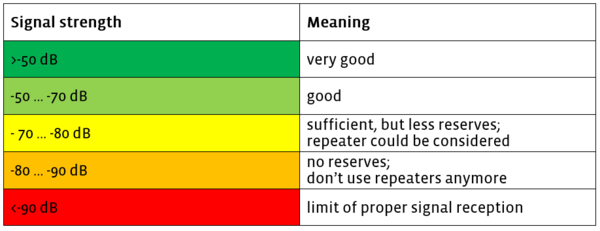FAQ – Frequently Asked Questions
Popular Questions
Which devices can be configured with airConfig?
The following devices are compatible with airConfig and can be configured via the software:
What is defined as a "good" signal strength?
The signal strength of EasySens® radio sensors is indicated with an RSSI value. RSSI means Received Signal Strength Indicator. This value is essential as it indicates the signal strength.
The RSSI value is shown in airScan or other tools when an EnOcean telegramm has been received. The higher the RSSI, is the better the singal strength is.
ATTENTION: The RSSI value is displayed negative!
The values have the following meanings:
Note:
The RSSI values shown in airScan refer to an internal antenna on the EnOcean USB Transceiver. If the receiver uses an external antenna, the real RSSI value is about 5 dB higher.
Do not connect the USB Tranceiver directly to an USB port of your PC because the near surroundings could have an influence on the measurement values. Use an USB extension or USB hub instead.
Try to improve the signal strength at your receiver with a good radio planning instead of using repeaters unnecessarily!
What is the threshold hysteresis?
The threshold hysteresis describes the value change that must occur so that an EasySens® sensor sends a new data telegram.
This hysteresis ensure that a new data telegram is just send if the measurement value has changed about the hyteresis value since the last measurement. This procedure is neccessary so that EasySens® sensors can work energy self-sufficient.
Example 1:
| Measuring range: | 0 °C bis +40 °C |
| Hysteresis: | ±0,8 °C |
| Last temperature value: | +21,5 °C |
The sensor will transmit a new data telegram, if the temperature is lower than 22,3 °C (21,5 °C + 0,8 °C) or higher than 20,7 °C (21,5 °C - 0,8 °C) with the next measurement.
Example 2:
| Measuring range: | -20 °C bis +60 °C |
| Hysteresis: | ±0,64 °C |
| Last temperature value: | +18,3 °C |
The sensor will transmit a new data telegram, if the temperature is lower than 18,94 °C ( 18,3 °C + 0,64 °C) or higher than 17,66 °C (18,3 °C - 0,64 °C) with the next measurement.
The hysteresis value dependes on the measurement range thus from the used EnOcean Profil (EEP).
Exclusively the SR06 LCD provides the possibility to change the hysteresis value with airConfig or the SR06 LCD configuration software.
How often does an EnOcean radio sensor transmit a telegram?
For reasons of energy saving, the EnOcean radio sensors transmit their values at preset intervals. Usually these intervals can be parameterized.
They consist of two components:
1. The WakeUp Time
This parameter describes the time period the sensor wakes up and performs a measurement. Though the result of this measurement is only transmitted if the <link record:tx_ricodynamicfaq_domain_model_question:tx_ricodynamicfaq_domain_model_question:65 _self>hysteresis value</link> is exceeded. If this value is not exceeding the hysteresis value, the sensor sleeps until the next measurement is performed.
2. The Heartbeat Cycle
This parameter describes the amount of measurements after which a new telegram is sent, even if the measured value has not changed signficiantly since the last measurement. This gives an indication to the receiver that the transmitter is still in operation - comparable to a heartbeat.
WakeUp Time and Heartbeat Cycle can be adjusted at most devices. This is done by integrated plug-in jumpers or software tools e.g. airConfig. Further Information on these parameters can be found in the corresponding datasheets.
Example:
| WakeUp time: | 100 s |
| Heartbeat cycle: | 10 |
| Send interval at very small value change: | 100 s x 10 = 1000 s ≙ 16,67 min |
Note:
WakeUp time and heartbeat cycle have a direct influence on the energy consumption of the device. A very short interval can drag the energy storage faster than it is charged. In addition the danger of a telegram collision and data loss increases with higher transmission intervals.
Which gases can VOC sensors detect?
VOC stands for Volatile Organic Compounds.
These are organic gas combinations that evaporate easily. Examples are:
-alcohols
-carbons
-organic acids
-cigarette smoke
-perfumes
-and so on
An exact list of all VOCs or a binding definition does not exist in literature.
VOC sensors do not detect a specific type of gas. They detect the sum of VOC in the ambient air. VOC sensors from Thermokon produce a relative signal from 0..100% to show the VOC concentration.


